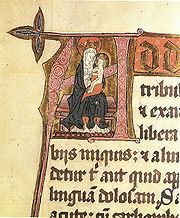
Munkeliv Abbey
Encyclopedia


Abbey
An abbey is a Catholic monastery or convent, under the authority of an Abbot or an Abbess, who serves as the spiritual father or mother of the community.The term can also refer to an establishment which has long ceased to function as an abbey,...
located at Nordnes in Bergen, Norway
Norway
Norway , officially the Kingdom of Norway, is a Nordic unitary constitutional monarchy whose territory comprises the western portion of the Scandinavian Peninsula, Jan Mayen, and the Arctic archipelago of Svalbard and Bouvet Island. Norway has a total area of and a population of about 4.9 million...
. It was one of the oldest monasteries in Norway, and also one of the wealthiest and best-documented.
History
Munkeliv Abbey was founded as a Benedictine abbey by King Eystein IEystein I of Norway
Eystein I Magnusson was king of Norway from 1103 to 1123.-Biography:Eystein became king, together with his brothers Sigurd and Olaf, when his father Magnus Barefoot died in 1103...
(Øystein Magnusson) in about 1110 and was dedicated to Saint Michael. The abbey was strategically positioned on the dominant height of Nordnes over the then newly-established town of Bergen, with a view to encouraging the town's development. Its first centuries were successful and prosperous, but the arrival of the Black Death
Black Death
The Black Death was one of the most devastating pandemics in human history, peaking in Europe between 1348 and 1350. Of several competing theories, the dominant explanation for the Black Death is the plague theory, which attributes the outbreak to the bacterium Yersinia pestis. Thought to have...
in the mid-14th century brought about a decline. In addition, the buildings suffered great damage in 1393 when the abbey was attacked by pirates. Thanks to its great wealth it managed to survive these catastrophes, but could not avoid a further decline.
In the 1420s it was taken over by the Bridgettines
Bridgettines
The Bridgettine or Birgittine Order is a monastic religious order of Augustinian nuns, Religious Sisters and monks founded by Saint Birgitta of Sweden in approximately 1350, and approved by Pope Urban V in 1370...
, with the Pope's approval, and was occupied as a double house by both monks and nuns. This was a very disturbed period: the abbey was again damaged by fire in 1455, when it was attacked by Hanseatic
Hanseatic League
The Hanseatic League was an economic alliance of trading cities and their merchant guilds that dominated trade along the coast of Northern Europe...
merchants pursuing Olav Nilsson, commander of the royal castle in Bergen
Bergenhus Fortress
Bergenhus fortress is a fortress located in Bergen, Norway. Bergenhus fortress is located in the entrance to the harbor in Bergen. This is one of the oldest and best preserved castles in Norway.-History:...
, who had sought sanctuary in the abbey. During the 1460s the occupants of Munkeliv were obliged to seek shelter in Hovedøya Abbey
Hovedøya Abbey
Hovedøya Abbey was a Cistercian monastery on the island of Hovedøya in Oslo Fjord, founded in 1147 and dissolved in 1532 just before the Reformation.-History:...
in Oslo
Oslo
Oslo is a municipality, as well as the capital and most populous city in Norway. As a municipality , it was established on 1 January 1838. Founded around 1048 by King Harald III of Norway, the city was largely destroyed by fire in 1624. The city was moved under the reign of Denmark–Norway's King...
. The monastery was re-constructed by the Cistercians and reoccupied by the Bridgettines in 1480.
When the abbey was suppressed in the Reformation
Protestant Reformation
The Protestant Reformation was a 16th-century split within Western Christianity initiated by Martin Luther, John Calvin and other early Protestants. The efforts of the self-described "reformers", who objected to the doctrines, rituals and ecclesiastical structure of the Roman Catholic Church, led...
the Bishop of Bergen took it over for his residence and used the church as the cathedral of Bergen. The entire building complex however was destroyed by fire in 1536.
The monks' herb garden near the Puddefjord was later cultivated by the Bergen pharmacist, Løveapoteket, for medicinal plants until the surrounding areas were built up in the 19th century.
Site and buildings
The monastery remains today are beneath the open space known as Klosteret ("the monastery") at Nordnes, near numbers 2-6, and nothing is visible.Excavations of the site took place in 1857 and 1860, during which many extremely well crafted structural fragments were recovered, now in the Kulturhistorisk Museum ("Museum of Cultural History"), now part of Bergen Museum
Bergen Museum
The Bergen Museum is a university museum in Bergen, Norway. Founded in 1825 with the intent of building large collections in the fields of culture and natural history, it became the grounds for most of the academic activity in the city, a tradition which has prevailed since the museum became part...
. These include the well-known marble head of Øystein Magnusson discovered by Nicolay Nicolaysen, supposedly the oldest-known portrait of a Norwegian.
At that time there were still remains of walls above ground up to a height of roughly 2.4 metres, but these were demolished after the excavations.
The church was approximately 32 metres in length and 11 metres wide, consisting of a single aisle the same width as the choir, which ended in an apse at the east end, and also a crypt. A west tower was added in the 13th century.
The conventual buildings were to the south of the church. Presumably under the Bridgettines, who carried out extensive building alterations, the cloisters were incorporated into the church.
Sources and external links
- Norges kloster i middelalderen: Munkeliv
- Bergenskartet: Munkeliv Abbey Map of historical Bergen

